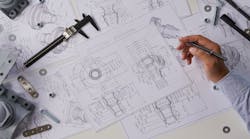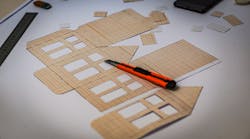Engineering Angles: Behind-the-scenes of fill-finish design
Fill-finish, which is the industry term for aseptic filling critical drugs into various delivery forms such as vials, pre-filled syringes, cartridges and ampules, is big business today. With the increased number of drugs entering the market, fill-finish CMOs are experiencing months-long backlogs and their own expansion projects are on the rise. This backlog is also driving an increase in in-house fill-finish expansions, where the biopharma industry is working hard to figure out how to safely make smaller batches of a wider variety of drugs.
This all-new series focuses on the importance of designing pharma’s processes and facilities to work optimally together. Monthly columns from experts in the engineering field will examine the logistical and manufacturing implications of a range of topics. Have a great column topic that you'd like to author for Engineering Angles? Contact our editors.
Any contamination can have a catastrophic effect on the product and patients, and lead to costly economic impacts for the manufacturer. In addition, a non-aseptic method can result in severe regulatory compliance issues, leading to a halt in production and even complete shut-down of an operation.
Whether you are planning a new construction or looking to retrofit an existing build, the biggest factors to consider are the risks associated with the process. Early facility planning becomes critical. How best to contain the product being filled? How do you protect the operators? How do you maintain product purity?
The engineers that design fill-finish facilities for CMOs and pharma have a few “behind-the-scenes” methods that help these projects in the very early stages. These tools model options that allow project teams to discuss a variety of approaches that will keep operators safe and maintain complete purity for the patients who need these medicines.
Many times, Computational Fluid Dynamics (CFD) modeling is used to simulate air streams over critical process areas such as point of fill and open formulations operations. Modeling is performed to evaluate air flow and ensure a uniform, downward directional flow as well as identify any undesirable eddies within the space. Ideally, any air that could hit the floor and come back up should be eliminated, as it could lead to product contamination. This technology can also help engineers recommend table placement and the location of personnel within the room, and identify if their location results in turbulence. Adjusting the position of the table and directing the air to move away from any personnel is preferable and will help reduce contamination risks.
CFD is also instrumental in determining the most ideal placement of low wall return air ducts within the fill-finish area. Performing CFD during design helps predict the results of the “air flow visualization” i.e. smoke test, which is performed after installation to show unidirectional air flow. This is essential when engaging with regulatory agencies for qualification and commissioning the facility for a Grade A area. Environmental monitoring is key in fill-finish and understanding air flow is vital to ensure adherence to FDA and EMEA regulations.
Another important tool for design optimization and risk reduction is Revit 3D Building Information Modeling (BIM) software. Through visualization and lean design principles, Revit helps to display any areas that could be easily overlooked, such as a common task performed by personnel where they may hit their head, or a piece of equipment that should be moved to allow for easier access. Recognizing these unanticipated situations early in the planning reduces manufacturing risks and costly design errors.
According to a Zion Market Research study, the global fill-finish manufacturing market is expected to reach around $5.15 billion by 2024. The biopharma industry will drive growth in the industry by a CAGR of 8.8 percent between 2018 and 2024. With this increasing demand for fill-finish CMOs, it is important for engineers to become more conversant with the language and tools used early on in the design process, whether you are a CMO, or a CMO customer.
A manufacturer needs to deeply understand the process, the equipment and the facility in order to determine the proper risk assessment and technical support needed. Taking a holistic approach to their design work is important; you need to navigate through current capabilities and anticipate future needs as well. Ultimately it is about having enough experience to anticipate what could happen and asking the right questions.
Facility design plays an important role identifying and addressing potential risks in producing and packaging biologics using a fill-finish production process. Understanding the entire design process as a whole and using modeling tools early on in the process can help to address and remedy these risks for optimal manufacturing.
Lisa Dorn is a process engineer who has been in the pharma industry for over 30 years, guiding clients on innovative aseptic filling facility design and operations.





